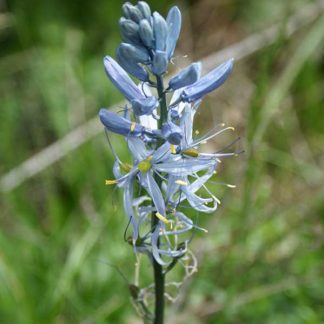edible
Showing 1–12 of 59 results
-

Allium acuminatum – tapertip onion
- umbels with 10-40 flowers atop a tall scape
- 6 magenta (or white) tepals per flower
- few leaves and all withered prior to flowering
- dry hillsides, sun-exposed rocky meadows and slope, volcanic areas
-

Allium brevistylum / short-styled onion
- clusters of 7-15 urn-shaped flowers atop a single flowering stalk
- pink with 6 tepals
- leaves much shorter than the inflorescence
- leaves grow from base and are "grass-like"
- swampy meadows and along streams
- smells like onions/garlic
-

Allium geyeri / Geyer’s onion
- smells like onions
- magenta (occasionally white) flowers on ca. 15 inch stem
- each flower urn-shaped with flared, pointy tips; yellow anthers
- leaves persistent during flowering
- rocky slopes in brush and pines, sometimes in dense stands
-

Allium schoenoprasum / chives
- globe-shaped umbels of pink flowers with darker midveins (stripes)
- hollow, tubular leaves and flower stalks
- smells like onions
- grows from bulbs in clumps or sometimes individually
- wild in wetlands, fens, meadows; cultivated in gardens
-

Amelanchier alnifolia / serviceberry
- erect shrub (3-18 ft), common in the Valley
- usually several trunks
- compact, fragrant white flower clusters
- star-like flowers
- smallish, light-green, oval leaves
- small, edible blue "berries" by July
- red/orange fall leaf color
-

Arctium minus / lesser burdock
- purple to pink to lavender thistle-like flowers with hooked bracts
- nasty hooked seed heads
- very large, heart-shaped leaves
- found in a wide variety of disturbed areas
-

Argentina anserina / silverweed
- silvery, compound leaves on low, creeping stems
- yellow, 5+ petaled flowers; lots of stamens
- fens, other wetlands, but also roadsides
-

Artemisia ludoviciana / white sage
- low, spreading perennial - up to 3 feet tall
- silvery leaves and stems (hairy)
- leaves lance shaped, but sometimes lobed
- shoots die back in winter
- aromatic
-

Balsamorhiza sagittata / arrowleaf balsamroot
- large, bright yellow, sunflower-like blossoms in early spring
- very large, more or less triangular basal leaves
- leaves appear silvery, or grey-green due to leaf hairs
- on open, fairly dry hillsides and ridges, often with sagebrush
-

Bistorta bistortoides / American bistort
- rocky areas, tundra/alpine
- inflorescence a 2" dense cylinder with many teeny white flowers
- notable protruding stamens
- leaves basal, long/thin and leathery
-

Blitum nuttallianum / Nuttall’s povertyweed
- ugly little creeping plant from a central stem
- arrow-shaped leaves with two prominent lobes, especially on lower leaves
- teeny clusters of teeny greenish flowers; no petals; in most leaf axils
- widespread, but usually exposed and weed-like
-

Camassia quamash / small camas
- immediately visible for its star-shaped blue flowers and yellow anthers
- flowers borne on a spike-like raceme, opening from the bottom up
- multiple flowers open at one time
- leaves are grass-like, growing from a bulb
- large seed capsules with ca. 30 roundish black seeds, ripe in late summer
Showing 1–12 of 59 results